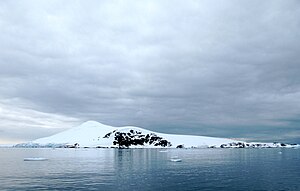
The Royal Danish Navy is the sea-based branch of the Danish Armed Forces force. The RDN is mainly responsible for maritime defence and maintaining the sovereignty of Danish territorial waters. Other tasks include surveillance, search and rescue, icebreaking, oil spill recovery and prevention as well as contributions to international tasks and forces.

The Norse exploration of North America began in the late 10th century, when Norsemen explored areas of the North Atlantic colonizing Greenland and creating a short term settlement near the northern tip of Newfoundland. This is known now as L'Anse aux Meadows where the remains of buildings were found in 1960 dating to approximately 1,000 years ago. This discovery helped reignite archaeological exploration for the Norse in the North Atlantic. This single settlement, located on the island of Newfoundland and not on the North American mainland, was abruptly abandoned.

The Second Battle of Copenhagen was a British bombardment of the Danish capital, Copenhagen, in order to capture or destroy the Dano-Norwegian fleet during the Napoleonic Wars. The incident led to the outbreak of the Anglo-Russian War of 1807, which ended with the Treaty of Örebro in 1812. The attack on Denmark, a neutral country, was heavily criticized internationally.

The Maine penny, also referred to as the Goddard coin, is a Norwegian silver coin dating to the reign of Olaf Kyrre King of Norway (1067–1093 AD). It was claimed to be discovered in Maine in 1957, and it has been suggested as evidence of Pre-Columbian trans-oceanic contact.

Paul or Poul Hansen Egede was a Dano-Norwegian theologian, missionary, and scholar who was principally concerned with the Lutheran mission among the Kalaallit people in Greenland that had been established by his father, Hans, in 1721.

A sternpost is the upright structural member or post at the aft end of a ship or a boat, to which are attached the transoms and the rearmost part of the stern.

William Frederick Durand was a United States naval officer and pioneer mechanical engineer. He contributed significantly to the development of aircraft propellers. He was the first civilian chair of the National Advisory Committee for Aeronautics, the forerunner of NASA.
The American-Scandinavian Foundation (ASF) is an American non-profit foundation dedicated to promoting international understanding through educational and cultural exchange between the United States and Denmark, Finland, Iceland, Norway, and Sweden. The Foundation's headquarters, Scandinavia House: The Nordic Center in America, is located at 58 Park Avenue, New York City.

Follins Pond is a brackish lake located on Cape Cod, separating the towns of Dennis, Massachusetts, and Yarmouth, Massachusetts. The lake is connected to Nantucket Sound via the Bass River.
Thomas Vilhelm Garde was a Danish naval officer, distinguished for his explorations in Greenland.

The Eastern Settlement was the first and by far the larger of the two main areas of Norse Greenland, settled c. AD 985 – c. AD 1000 by Norsemen from Iceland. At its peak, it contained approximately 4,000 inhabitants. The last written record from the Eastern Settlement is of a wedding in Hvalsey in 1408, placing it about 50–100 years later than the end of the more northerly Western Settlement.

Lauge Koch was a Danish geologist and Arctic explorer.

Vice Admiral Sir Georg Carl Amdrup, RN was a Danish naval officer, Vice Admiral and Greenland researcher.

Straumfjörður (Icelandic), or Straumfjǫrðr, sometimes anglicised to Straumsfjordr, Straumfjordr, Straumsfjord or Straumfjord, is according to the Sagas of Icelanders a fjord in Vinland where Thorfinn Karlsefni set up a temporary settlement. It is described in the Saga of Erik the Red, but not in the Greenland saga. Its name translates to "Current-fjord", "Stream-fjord" or "Tide-fjord".

Herjolfsnes was a Norse settlement in Greenland, 50 km northwest of Cape Farewell. It was established by Herjolf Bardsson in the late 10th century and is believed to have lasted some 500 years. The fate of its inhabitants, along with all the other Norse Greenlanders, is unknown. The site is known today for having yielded remarkably well-preserved medieval garments, excavated by Danish archaeologist Poul Nörlund in 1921. Its name roughly translates as Herjolf's Point or Cape.

Andreas Christian Riis Carstensen was a Danish painter who specialized in maritime scenes, notably of Greenland.

Andreas Peter Hovgaard was a Danish naval officer and Arctic explorer.
This list of Danish shipbuilders, arranged by year, presents builders of Danish warships from the late 17th century to mid-19th century. It names the Heads of Naval Construction (Fabrikmester) and includes lesser shipbuilders to the Danish Royal Navy. It does not include purely commercial shipbuilders.

Diderich de Thurah (1704–1788) was a military cadet, a naval officer in the Royal Danish-Norwegian navy, shipbuilder and fabrikmester, artist and publisher.
















